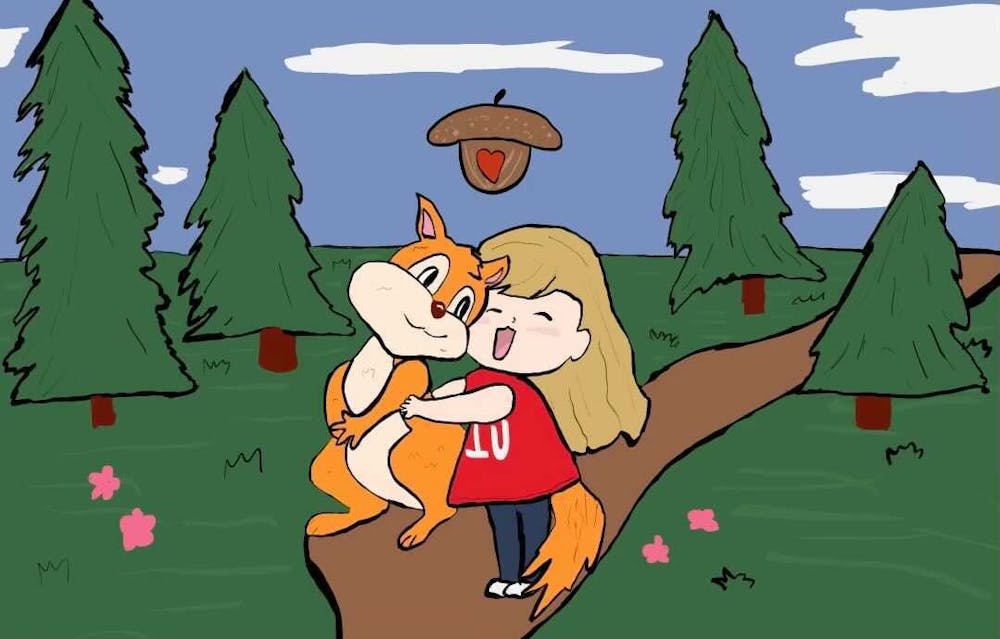To feed or not to feed? That is the question many Hoosiers may find themselves debating while encountering the friendly furballs around campus. After my last article about how feeding the squirrels is dangerous, I realized that the IU population has developed a devotion and adoration for the little creatures as multiple accounts expressed their opinions on the matter.
One commenter I reached out to is the owner of the IU squirrels page @squirrels_at_iu, Daisy Smith. The page was started in 2015 and taken over by Smith in 2018 after finding an injured opossum on campus and contacting the account for help since it was so late at night. Smith studied Recreational Therapy and Counseling Psychology during her undergrad and is now in the School of Public Health for her graduate degree. She has been running the page since she was a freshman at IU, which now stands at approximately 17,000 followers.
Smith said Hoosiers should be cautious of what they feed their squirrels, but shouldn’t completely abstain from feeding them. Apples, unsalted nuts and seeds were just three foods Smith mentioned that could allow the squirrels to keep their healthy diet balanced with their interaction with humans.
The biggest thing is making sure not to feed the squirrels salty foods since these can end up hurting their kidneys.
[Related: A beaver has found a home on IU's Campus River]
Along with dietary advice, Smith’s page also follows squirrels around campus who have been identified through their facial features, bone structure, scars, ears and unique nose prints. It has been found that multiple family trees of squirrels tend to stay in the same area through generations.
For example, Hazel has been deemed one of the queens of Dunn Meadow and her offspring are able to be identified because of her physical traits. A dark whisker base, wide cleft palate and defined cheeks are just a few things that allow Smith and others to identify her.
Snoopy wears his tail on his right side, has a dark line birthmark pointing at 10 o’clock, and a slight “tenting” of his cleft. He can also be identified by his walk, slow and shouldering like a bear. He’s identified as a “lone ranger,” usually keeping to himself.
Moose has distinct black spots, Tyson has defined eyelids and George is right-pawed while also looking short and round.
There are more identified squirrels that can be found on the page, all varying in their walking styles, their sociability and other features, like if they’re right-pawed or left-pawed.
Smith said that she has grown to love the squirrels on IU’s campus in many ways. As I continued my foraging in the Instagram page, I can see why, too. Each squirrel is friendly and gentle, holding differing personality traits from one another.
Sampson is one squirrel that is seven years old, holding the largest territory and seemingly popular with the ladies. Each squirrel holds their own territory, crossing over each other to simply visit with one another to say “hi.”
[Related: Indiana DNR encourages Monroe County residents to continue refraining from feeding birds]
I honestly didn’t know squirrels could vary so much. I had always just looked at every squirrel the same, not realizing they could have different names, distinctive features and specific territories.
I’m glad people like Smith run these kinds of accounts because they hold a great deal of information that can be useful for how to better take care of the wildlife on campus. By taking better care of our environment and squirrels, I think we can begin to recognize the importance of taking care of ourselves.
Just like humans, each squirrel is recognized for their differences. The different features of our faces or whether or not we are right-handed or left-handed is what makes us who we are, just like how it allows a squirrel to be uniquely and proudly themselves.
Carolyn Marshall is a sophomore majoring in media studies with a focus in TV, digital, and film production also minoring in English.






